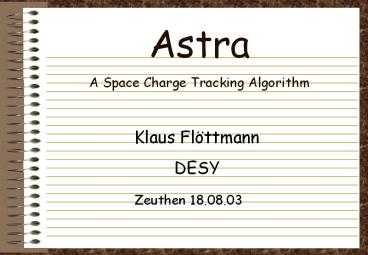Astra A Space Charge Tracking Algorithm - PowerPoint PPT Presentation
Title:
Astra A Space Charge Tracking Algorithm
Description:
Program development started in '96 based on a precursor by ... of rings (transversely) and slices (longitudinally) is set up for the space charge calculation. ... – PowerPoint PPT presentation
Number of Views:849
Avg rating:3.0/5.0
Title: Astra A Space Charge Tracking Algorithm
1
AstraA Space Charge Tracking Algorithm
Klaus Flöttmann DESY
Zeuthen 18.08.03
2
General
- Program development started in 96 based on a
precursor by Ch. Stolzenburg - written in Fortran 90, runs on
- Windows PC
- LINUX PC
- SUN UNIX
- MAC OS
- 50 -100 users
3
Astra design philosophy
- the program is user oriented, i.e. it is designed
- to be easy to use
- to be robust against user errors
- to avoid ambiguous parameters
- Astra supports parameters scans.
- Astra is complemented by graphics and analysis
tools.
4
Astra design philosophy
- in order to avoid the development of diverging
versions only executables are distributed. - to give the user insight into what is going on in
the code a number of tools are provided. Examples
will be shown in the following.
5
Space Charge Calculation
- a grid consisting of rings (transversely) and
slices (longitudinally) is set up for the space
charge calculation. - the grid size matches the dimensions of the
bunch, with some additional grid cells added
automatically outside of the bunch.
6
Space Charge Calculation
- the space charge field is calculated in the
average rest frame of the bunch assuming a
constant charge density inside the ring elements. - remaining non-relativistic velocity components
in the average rest frame can be taken into
account. - in the center of the bunch statistical problems
may arise due to the small cell volume despite
the higher charge density.
7
Example radial electric space charge field of a
bunch as calculated by Astra, plotted with
fieldplot
uniform charge density, 1000 macro-particles,
10x10 grid cells
8
Example radial electric space charge field of a
bunch as calculated by Astra, plotted with
fieldplot
uniform charge density, 1000 macro-particles,
10x10 grid cells increased cell size in the
center
9
Example radial electric space charge field of a
bunch as calculated by Astra, plotted with
fieldplot
uniform charge density, 5000 macro-particles,
10x10 grid cells adjusted cell size
10
Space Charge Calculation
The grid and the space charge field are scaled as
the bunch propagates through the beam line
according to varying bunch dimensions, charge and
energy.
When the scaling factor exceed a user defined
limit a new space charge calculation is
automatically initiated.
11
Example development of electric space charge
field as seen by probe particles. (Calculation
with Astra, plotted with lineplot.)
L-band rf gun 5000 macro-particles, 10x10 grid
cells
12
Example development of electric space charge
field as seen by probe particles. (Calculation
with Astra, plotted with lineplot.)
L-band rf gun 5000 macro-particles, 10x10 grid
cells
13
Example development of space charge scaling
factors in Astra.
L-band rf gun 5000 macro-particles, 10x10 grid
cells
Cavity shape
14
Example development of time steps.
L-band rf gun 5000 macro-particles, 10x10 grid
cells
15
Emission of particles from the cathode
16
Emission of particles from the cathode
Random distribution with clusters and voids.
17
Emission of particles from the cathode
Regular distribution with mis-matched grid.
18
Emission of particles from the cathode
Quasi random distribution based on a Hammersley
sequence.
19
Emission of particles from the cathode
Particles are sorted w. r. t. their emission
time. After the emission of a single particle
the space charge field is scaled with
When a complete time step is fulfilled a new
space charge field calculation is initiated.
Some resolution below a time step.
20
Emission of particles from the cathode
The grid is set up successively as the particles
come out of the cathode.
Equivalently a mirror charge bunch is generated
21
Example Space Charge field at the cathode during
emission.
1 nC, 3.0 mm dia.
Plate capacitor
22
Example Space Charge field at the cathode during
emission.
space charge limited emission 5 nC launched 2.3
nC emitted 3.0 mm dia.
23
Emission of particles from the cathode
In Astra it is not necessary to assign the same
charge to all macro particles. This allows to
simulate the emission self-consistently, e.g.
when the quantum efficiency of the cathode
depends on the applied accelerating field,
so-called Schottky effect.
24
Example Charge vs. phase of an rf gun.
1 nC, 40 MV/m
25
Example Charge vs. phase of an rf gun.
1 nC, 40 MV/m with strong Schottky effect
26
Example Charge vs. phase of an rf gun.
1 nC, 40 MV/m without space charge
27
Astra graphics tools
- for the data visualization and analyses three
graphics programs are provided - fieldplot
- lineplot
- postpro
- the plot programs are menu controlled
28
Some menu pages of graphic programs
29
Slice emittance plot
30
Core emittance plot
31
Acknowledgement
- Thanks to all colleagues who contributed to the
program development, especially Christoph
Stolzenburg, Phillipe Piot, Bagrat Grigorian and
Sven Reiche.

